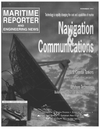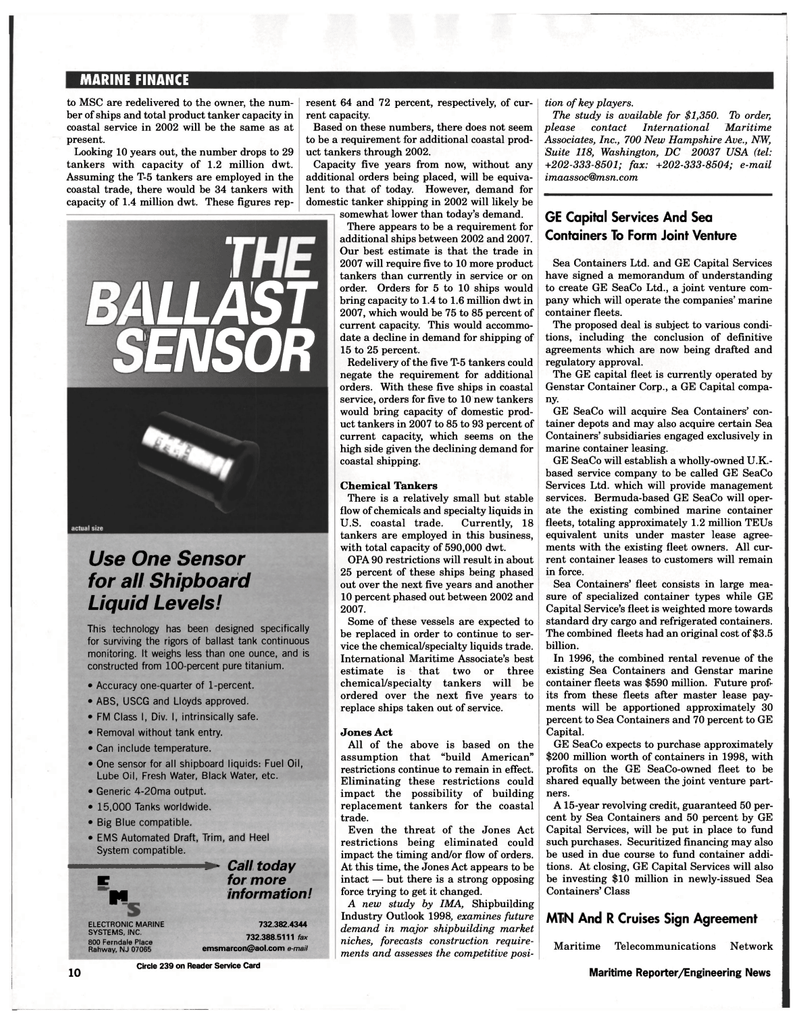
Page 10: of Maritime Reporter Magazine (November 1997)
Read this page in Pdf, Flash or Html5 edition of November 1997 Maritime Reporter Magazine
MARINE FINANCE to MSC are redelivered to the owner, the num- ber of ships and total product tanker capacity in coastal service in 2002 will be the same as at present.
Looking 10 years out, the number drops to 29 tankers with capacity of 1.2 million dwt.
Assuming the T-5 tankers are employed in the coastal trade, there would be 34 tankers with capacity of 1.4 million dwt. These figures rep-
THE
ILLAST
ENSOR
Use One Sensor for all Shipboard
Liquid Levels!
This technology has been designed specifically for surviving the rigors of ballast tank continuous monitoring. It weighs less than one ounce, and is constructed from 100-percent pure titanium. • Accuracy one-quarter of 1-percent. • ABS, USCG and Lloyds approved. • FM Class I, Div. I, intrinsically safe. • Removal without tank entry. • Can include temperature. • One sensor for all shipboard liquids: Fuel Oil,
Lube Oil, Fresh Water, Black Water, etc. • Generic 4-20ma output. • 15,000 Tanks worldwide. • Big Blue compatible. • EMS Automated Draft, Trim, and Heel
System compatible. • Call today
E for more jp| information! resent 64 and 72 percent, respectively, of cur- rent capacity.
Based on these numbers, there does not seem to be a requirement for additional coastal prod- uct tankers through 2002.
Capacity five years from now, without any additional orders being placed, will be equiva- lent to that of today. However, demand for domestic tanker shipping in 2002 will likely be somewhat lower than today's demand.
There appears to be a requirement for additional ships between 2002 and 2007.
Our best estimate is that the trade in 2007 will require five to 10 more product tankers than currently in service or on order. Orders for 5 to 10 ships would bring capacity to 1.4 to 1.6 million dwt in 2007, which would be 75 to 85 percent of current capacity. This would accommo- date a decline in demand for shipping of 15 to 25 percent.
Redelivery of the five T-5 tankers could negate the requirement for additional orders. With these five ships in coastal service, orders for five to 10 new tankers would bring capacity of domestic prod- uct tankers in 2007 to 85 to 93 percent of current capacity, which seems on the high side given the declining demand for coastal shipping.
Chemical Tankers
There is a relatively small but stable flow of chemicals and specialty liquids in
U.S. coastal trade. Currently, 18 tankers are employed in this business, with total capacity of 590,000 dwt.
OPA 90 restrictions will result in about 25 percent of these ships being phased out over the next five years and another 10 percent phased out between 2002 and 2007.
Some of these vessels are expected to be replaced in order to continue to ser- vice the chemical/specialty liquids trade.
International Maritime Associate's best estimate is that two or three chemical/specialty tankers will be ordered over the next five years to replace ships taken out of service.
ELECTRONIC MARINE
SYSTEMS, INC. 800 Ferndale Place
Rahway, NJ 07065 732.382.4344 732.388.5111 fax [email protected] e-mail
Jones Act
All of the above is based on the assumption that "build American" restrictions continue to remain in effect.
Eliminating these restrictions could impact the possibility of building replacement tankers for the coastal trade.
Even the threat of the Jones Act restrictions being eliminated could impact the timing and/or flow of orders.
At this time, the Jones Act appears to be intact — but there is a strong opposing force trying to get it changed.
A new study by IMA, Shipbuilding
Industry Outlook 1998, examines future demand in major shipbuilding market niches, forecasts construction require- ments and assesses the competitive posi- 10 Circle 239 on Reader Service Card tion of key players.
The study is available for $1,350. To order, please contact International Maritime
Associates, Inc., 700 New Hampshire Ave., NW,
Suite 118, Washington, DC 20037 USA (tel: +202-333-8501; fax: +202-333-8504; e-mail imaassoc@msn. com
GE Capital Services And Sea
Containers To Form Joint Venture
Sea Containers Ltd. and GE Capital Services have signed a memorandum of understanding to create GE SeaCo Ltd., a joint venture com- pany which will operate the companies' marine container fleets.
The proposed deal is subject to various condi- tions, including the conclusion of definitive agreements which are now being drafted and regulatory approval.
The GE capital fleet is currently operated by
Genstar Container Corp., a GE Capital compa- ny.
GE SeaCo will acquire Sea Containers' con- tainer depots and may also acquire certain Sea
Containers' subsidiaries engaged exclusively in marine container leasing.
GE SeaCo will establish a wholly-owned U.K- based service company to be called GE SeaCo
Services Ltd. which will provide management services. Bermuda-based GE SeaCo will oper- ate the existing combined marine container fleets, totaling approximately 1.2 million TEUs equivalent units under master lease agree- ments with the existing fleet owners. All cur- rent container leases to customers will remain in force.
Sea Containers' fleet consists in large mea- sure of specialized container types while GE
Capital Service's fleet is weighted more towards standard dry cargo and refrigerated containers.
The combined fleets had an original cost of $3.5 billion.
In 1996, the combined rental revenue of the existing Sea Containers and Genstar marine container fleets was $590 million. Future prof- its from these fleets after master lease pay- ments will be apportioned approximately 30 percent to Sea Containers and 70 percent to GE
Capital.
GE SeaCo expects to purchase approximately $200 million worth of containers in 1998, with profits on the GE SeaCo-owned fleet to be shared equally between the joint venture part- ners.
A 15-year revolving credit, guaranteed 50 per- cent by Sea Containers and 50 percent by GE
Capital Services, will be put in place to fund such purchases. Securitized financing may also be used in due course to fund container addi- tions. At closing, GE Capital Services will also be investing $10 million in newly-issued Sea
Containers' Class
MTN And R Cruises Sign Agreement
Maritime Telecommunications Network
Maritime Reporter/Engineering News

 9
9

 11
11
